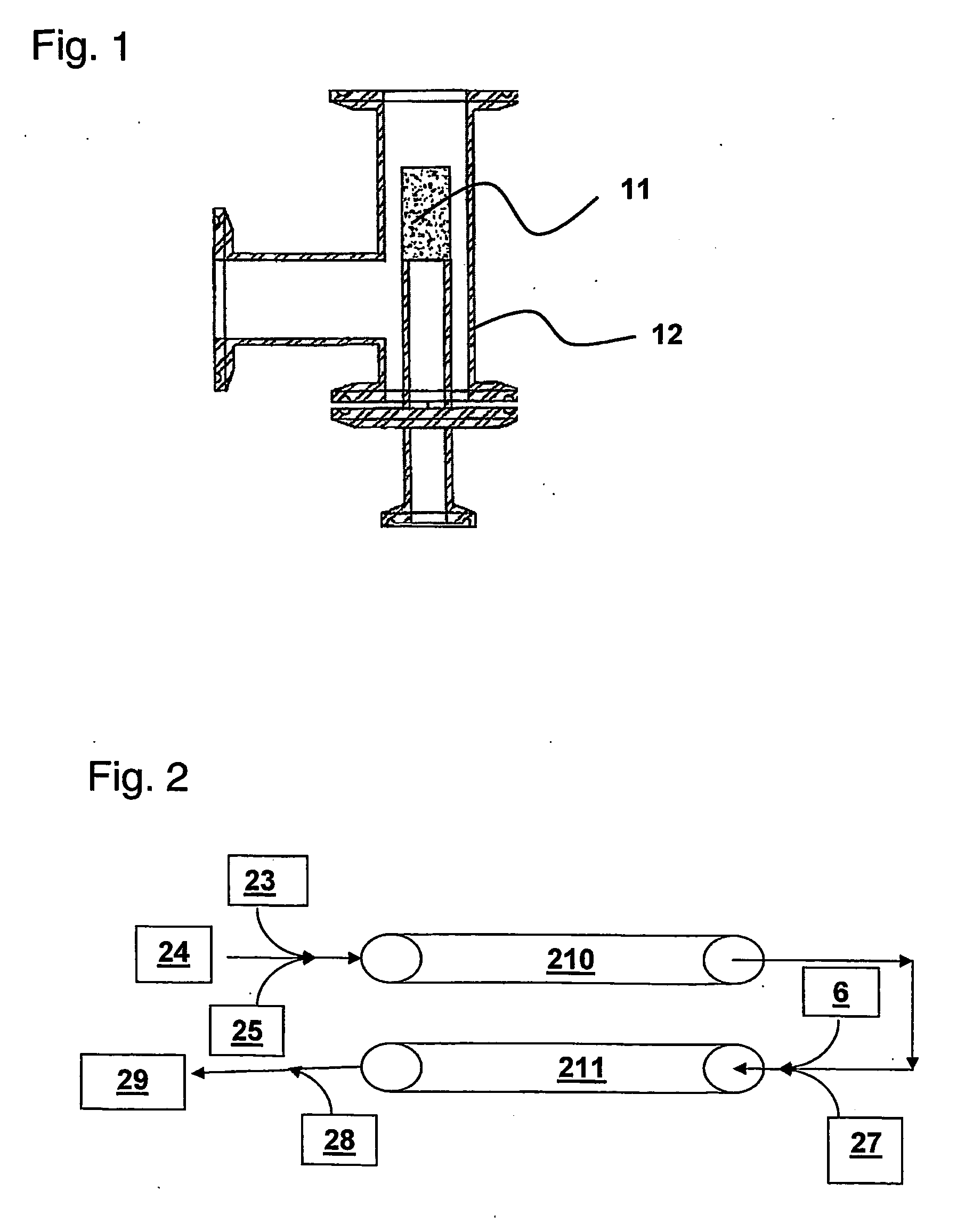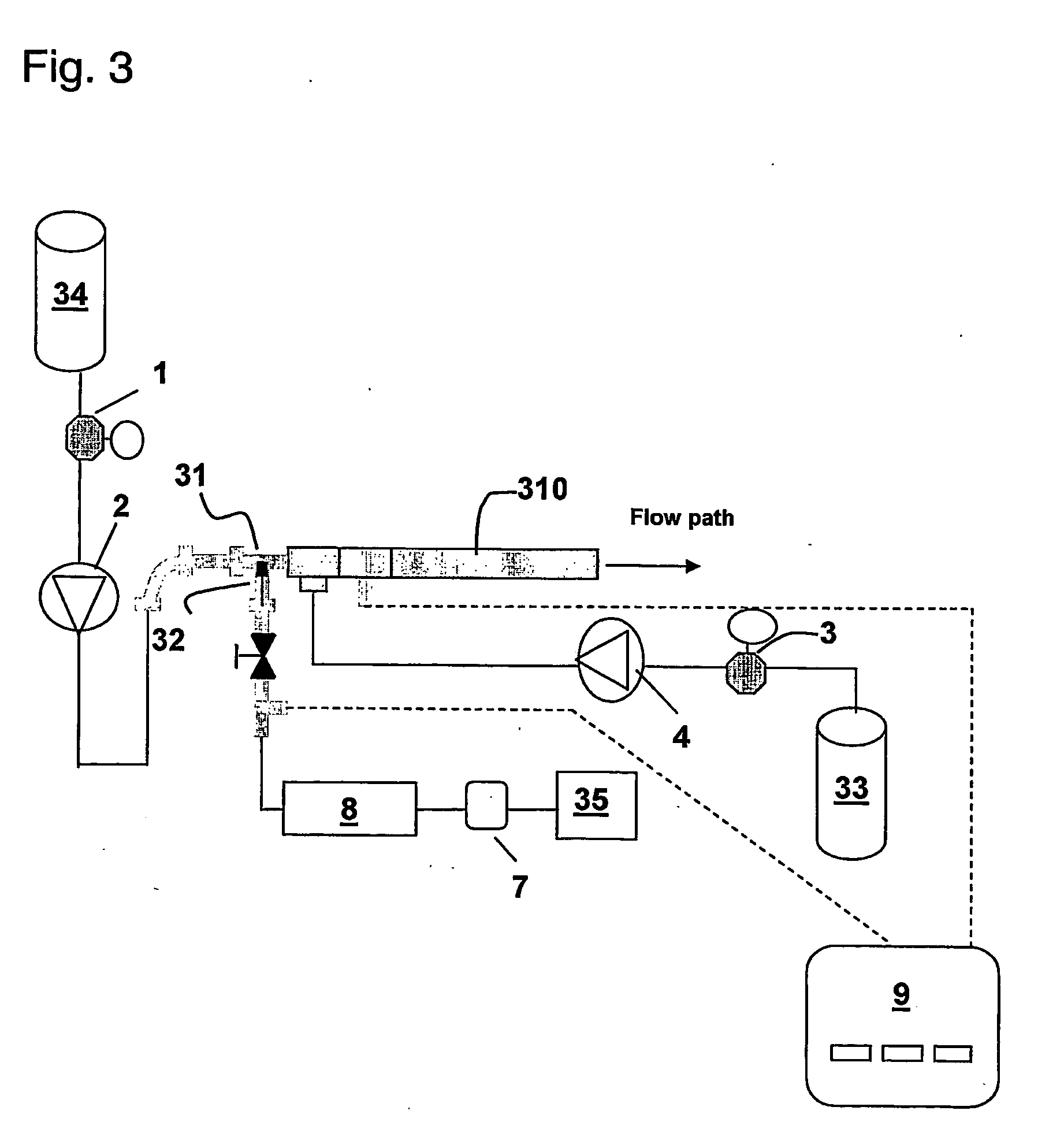Apparatus and method for preparative scale purification of nucleic acids
a nucleic acid and scale technology, applied in the field of nucleic acid purification methods, can solve the problems of unmet needs, scale-up difficulty or impracticality, and the safety or efficacy of the resulting nucleic acid, and achieve the effect of convenient automaticity
- Summary
- Abstract
- Description
- Claims
- Application Information
AI Technical Summary
Benefits of technology
Problems solved by technology
Method used
Image
Examples
example 1
EXAMPLE 1
[0052] In one embodiment, bacterial cells are lysed by contact with a strongly alkaline solution in the presence of a detergent. A typical alkaline lysis solution is 0.2N sodium hydroxide (NaOH) with 1% sodium dodecyl sulfate (SDS). The classical alkaline lysis procedure of Birnboim and Doly involved lysis of bacteria on a mini-preparative scale in which alkaline conditions effected selective denaturation of chromosomal DNA that renatured upon neutralization and, together-with cellular proteins and debris, formed an insoluble “clot” that could be removed by centrifugation. The neutralization step has been also termed “precipitation” for the formation of the insoluble “precipitate.” The plasmid DNA remains in the fluid phase of the “neutralized” solution. On a preparative scale, various means have been employed to clarify the alkaline lysate including centrifugation, sedimentation, and filtration. Filtration means have included depth filtration (U.S. Pat. No. 6,268,492) and ...
example 2
EXAMPLE 2
[0058] Initial Testing: Location of air introduction: During lysis using the static mixer assembly, air was introduced via a separate peristaltic pump into a ⅜″ i.d. static mixer arrangement as diagrammatically depicted in FIG. 2. Inside each of Static Mixers 210 and 211 are 36 alternating twisted elements that facilitate better mixing (each of Static Mixers 210 and 211 are formed by connecting in series 3 individual 12 element mixers: ½ inch o.d. KENICS ½ KMR-SAN 12 sanitary mixers obtainable from Chemineer, Inc.). The flow rates for cell re-suspension 23 (E. coli transformed with plasmid pMB290, OD 150), cell lysis buffer 24 (0.2N NaOH; 1% SDS), precipitation buffer 27 (3M KOAc; 2M HOAc) and neutralization buffer 28 (2.5M Tris-base) were 370, 620, 310, and 265 mL / min, respectively. The air was introduced at two alternative locations 5 or 6 via a “T” connection into the static mixer assembly. For each inlet, three settings (600, 900, 1800 mL / min) of air were tested. The se...
example 3
EXAMPLE 3
[0068] Sparge Stone Development: A set of experiments was run on a ⅝″ i.d. static mixer setup similar to the arrangement shown in FIG. 2 (each of Static Mixers 210 and 211 are formed by connecting in series 3 individual 12 element mixers: ¾ inch o.d. KENICS ¾ KMR-SAN 12 sanitary mixers obtainable from Chemineer, Inc.). In this experiment, air was delivered into the static mixers by means of a stainless steel “sparge stone” located at first Air Inlet 5. A schematic diagram of one embodiment of a sparge stone including optional housing is shown in FIG. 1. Referring to FIG. 1, sparge stone 11 features 2 micron pores to produce air bubbles less than 1 mm in diameter. During operation, cell lysis buffer enters from one port of housing 12 and completely fills the interior space. Air is controllably introduced through a bottom port of housing 12 under pressure and enters the lysate stream through the sparge stone 11 to produce fine bubbles in the lysate stream. The airflow rate wa...
PUM
| Property | Measurement | Unit |
|---|---|---|
| diameter | aaaaa | aaaaa |
| diameter | aaaaa | aaaaa |
| linear velocity | aaaaa | aaaaa |
Abstract
Description
Claims
Application Information
 Login to View More
Login to View More - R&D
- Intellectual Property
- Life Sciences
- Materials
- Tech Scout
- Unparalleled Data Quality
- Higher Quality Content
- 60% Fewer Hallucinations
Browse by: Latest US Patents, China's latest patents, Technical Efficacy Thesaurus, Application Domain, Technology Topic, Popular Technical Reports.
© 2025 PatSnap. All rights reserved.Legal|Privacy policy|Modern Slavery Act Transparency Statement|Sitemap|About US| Contact US: help@patsnap.com



